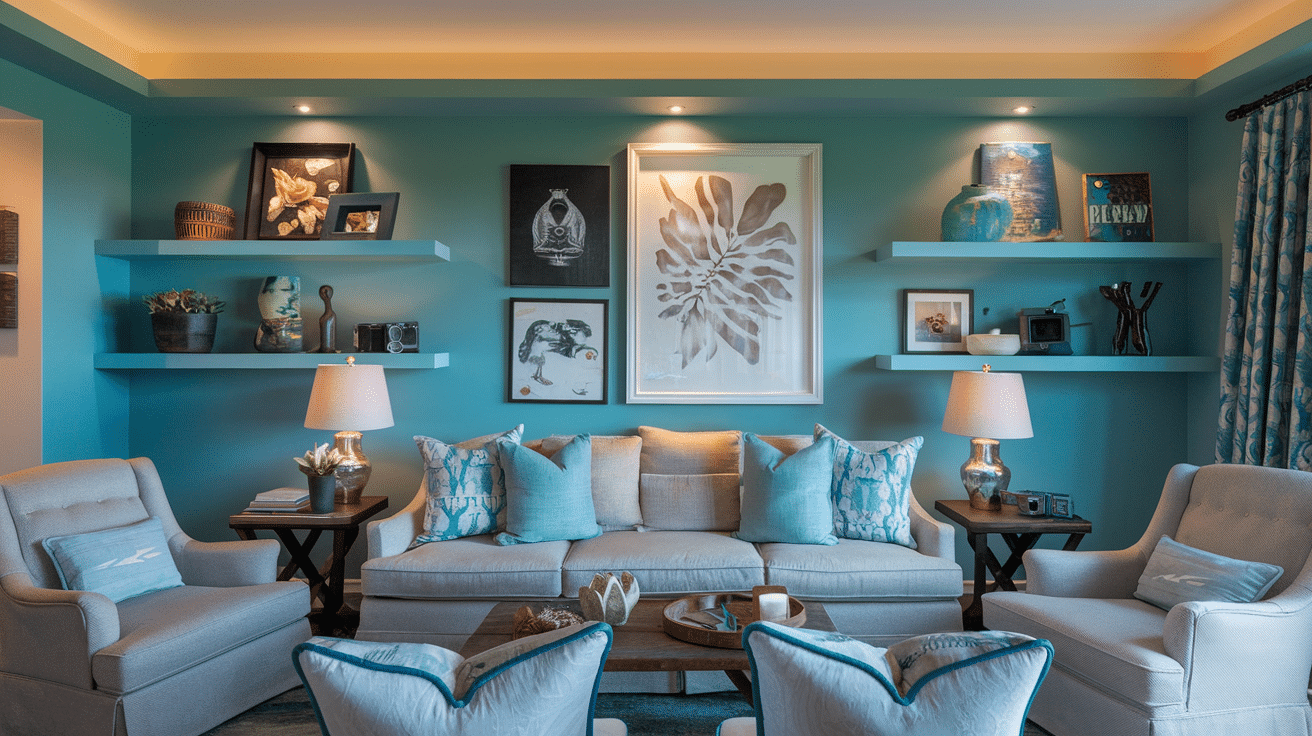Are your rooms plain and uninteresting? Many homeowners feel stuck with spaces that lack personality and warmth.
Good interior design isn’t just for magazines or social media—it’s possible in your own home, with simple changes anyone can make.
By focusing on thoughtful design choices, you can create spaces that reflect your style, improve your mood, and impress your guests.
From color selection to furniture placement, small updates can completely change how you feel about your home.
What is Emphasis in Interior Design?
Emphasis in interior design is a key principle that creates a focal point in a room.
It draws attention to specific areas or items that you want people to notice first. Effective emphasis helps guide the eye through a space and prevents rooms from feeling flat or boring.
Without a clear focal point, visitors might not know where to look, making the space feel disorganized or plain.
- Natural focal points include fireplaces, large windows, or built-in shelving that already stand out in a room.
- Created focal points can be made with bold wall colors, statement furniture pieces, or eye-catching artwork.
- Balance is essential – too many focal points confuse, while none leaves rooms feeling dull.
- Scale matters – larger items naturally create more emphasis, so size should match the room’s proportions.
Key Elements to Create Emphasis
- Color contrast draws the eye immediately when you place bright or dark colors against neutral backgrounds.
- Size variation works effectively when you include one noticeably larger item among similar pieces.
- Unique shapes stand out naturally when surrounded by more conventional forms.
- Texture differences create visual interest through the contrast of smooth surfaces against rough or patterned ones.
- Strategic lighting highlights specific areas or objects when directed properly.
- Positioning matters greatly – items placed at eye level or in the center of a room get noticed first.
- Repetition with a twist catches attention when you group similar items but make one distinctly different.
- Negative space around an object makes it more noticeable by creating breathing room.
5 Techniques for Achieving Emphasis in Interior Design
Creating focal points and visual interest is essential for dynamic, memorable spaces. These techniques help direct attention and establish a hierarchy within your home.
1. Color Blocking
Use bold color choices to create visual interest in key areas. Paint a single wall in a striking shade or add colorful furniture against a neutral background.
This technique works in both small and large spaces to direct attention exactly where you want it.
Pro Tip: Limit strong colors to 20% of the room to avoid overwhelming the space.
2. Statement Furniture
Place one standout piece of furniture that differs from the rest of the room. This could be a uniquely shaped chair, an oversized sofa, or a table with unusual features.
The piece should reflect your style while acting as a conversation starter.
Designer Note: Position statement pieces where they’ll be seen first when entering the room.
3. Architectural Features
Highlight built-in elements like fireplaces, windows, or ceiling beams. Frame these features with complementary furniture arrangements or accent colors.
These permanent elements create natural focal points that anchor the entire room.
Quick Tip: Use mirrors to reflect and enhance architectural features.
4. Strategic Art Placement
Hang artwork slightly larger than surrounding pieces or create a gallery wall with one central image.
Art provides an instant focal point and allows you to express your personality without major renovations or expenses.
Display Secret: For maximum impact, hang art at eye level (57-60 inches from the floor to the center).
5. Textural Contrast
Mix different textures to create visual weight in specific areas. For example, combine smooth surfaces with rough ones, like glass tables with woven baskets or velvet pillows on leather couches.
This creates depth through touch as well as sight.
Design Hint: Group three different textures together for the most pleasing visual effect
Architectural Details to Draw Attention
1. Fireplace Enhancement: Make fireplaces the center of your room by painting the surround a different color than your walls. To increase the height of the mantel, add a large mirror or artwork.
2. Window Treatment Focus: Call attention to beautiful windows using fabric treatments that frame rather than hide them. Floor-to-ceiling curtains hung wide of the actual window make the area seem larger.
3. Ceiling Details: Look up to find often-missed design chances. Paint ceiling beams to contrast with the ceiling color or add simple molding to create patterns.
4. Built-in Bookcase Styling: Make built-in shelves stand out by painting the back walls a different color than your room—group books and objects in small clusters with some space between them.
5. Wall Paneling Highlight: If your home has wall paneling or wainscoting, accent it with paint colors that create contrast between the panels and wall. This traditional detail becomes modern when used as a design feature.
Using Scale to Emphasize Design Features
1. Go Big or Go Home
A single, oversized piece creates an instant focal point that commands attention.
Whether it’s a dramatic floor lamp arching over a seating area, an expansive art canvas dominating a wall, or an unusually large pendant light, these statement pieces become design anchors that define the entire room’s character while creating visual excitement.
2. The David & Goliath Effect
The strategic contrast between very small and large elements highlights both through dramatic juxtaposition.
This technique creates visual tension that draws the eye naturally—a delicate bud vase on a substantial console table, miniature decorative objects arranged on oversized shelving, or a petite accent chair paired with a grand sectional.
This contrast adds personality while emphasizing each element’s unique characteristics.
3. Vertical Drama
Elements that draw the eye upward create a sense of expansiveness and architectural significance.
Floor-to-ceiling bookshelves, tall decorative plants, high-backed chairs, or elongated mirrors trick the eye into perceiving more space while establishing a strong vertical line that adds sophistication.
This technique is particularly effective in rooms with standard-height ceilings that need visual lifting.
4. Optical Illusion Masters
Strategic placement manipulates perception to enhance architectural features.
Mounting curtain rods 4-6 inches above window frames and extending them 10 inches beyond window edges makes windows appear significantly larger.
Similarly, hanging art slightly lower than standard height draws the eye down in tall rooms, creating intimacy, while mirrors positioned to reflect light or views create depth illusions.
5. Rule of Three Heights
Arranging similar items at varying heights establishes a visual rhythm that guides the eye through the space naturally.
This principle works effectively with bookshelf styling, console table arrangements, and wall galleries.
The staggered heights create movement that prevents design stagnation while maintaining cohesiveness through item similarity.
6. Less But Larger
In smaller spaces, fewer substantial pieces create more impact than multiple small items.
A single generous sectional rather than several separate seating pieces, one distinctive coffee table instead of nesting tables, or a substantial area rug that properly frames the space all contribute to a more purposeful, less cluttered environment.
This approach establishes clear focal points while actually making small rooms feel more spacious.
Common Interior Design Mistakes
1. Overcrowding Spaces: Many homeowners fill every inch with furniture and décor, creating visual clutter. Instead, embrace negative space—allow rooms to breathe by keeping 20-30% of surfaces empty.
A thoughtfully curated space creates more impact than an abundance of items.
2. Pushing Furniture Against Walls: This habit makes rooms feel like waiting areas rather than inviting spaces.
Pull furniture away from walls to create conversation areas and improve flow. Even a few inches can dramatically transform your room’s feel and functionality.
3. Neglecting Proper Lighting: Relying solely on overhead lighting creates harsh, unflattering environments. Implement layered lighting with ambient, task, and accent sources at varying heights for depth and warmth.
Good lighting transforms a room’s mood instantly.
4. Matching Everything Perfectly: Coordinated furniture sets make spaces feel impersonal and dated.
Mix complementary styles, textures, and periods for a collected, authentic look that tells your story. The most inviting homes balance cohesion with thoughtful contrast.
Conclusion
Creating a home that truly feels like yours doesn’t require design expertise or a hefty budget—just intentionality.
Focus on balancing colors, incorporating meaningful pieces, and creating functional layouts that serve your lifestyle. Start with one room, allowing your space to evolve naturally.
Remember, the most successful interior design reflects your personality while enhancing daily life.
By making purposeful choices, you’ll craft spaces that not only look beautiful but also support your well-being. Your home is your canvas—make it authentically yours.













